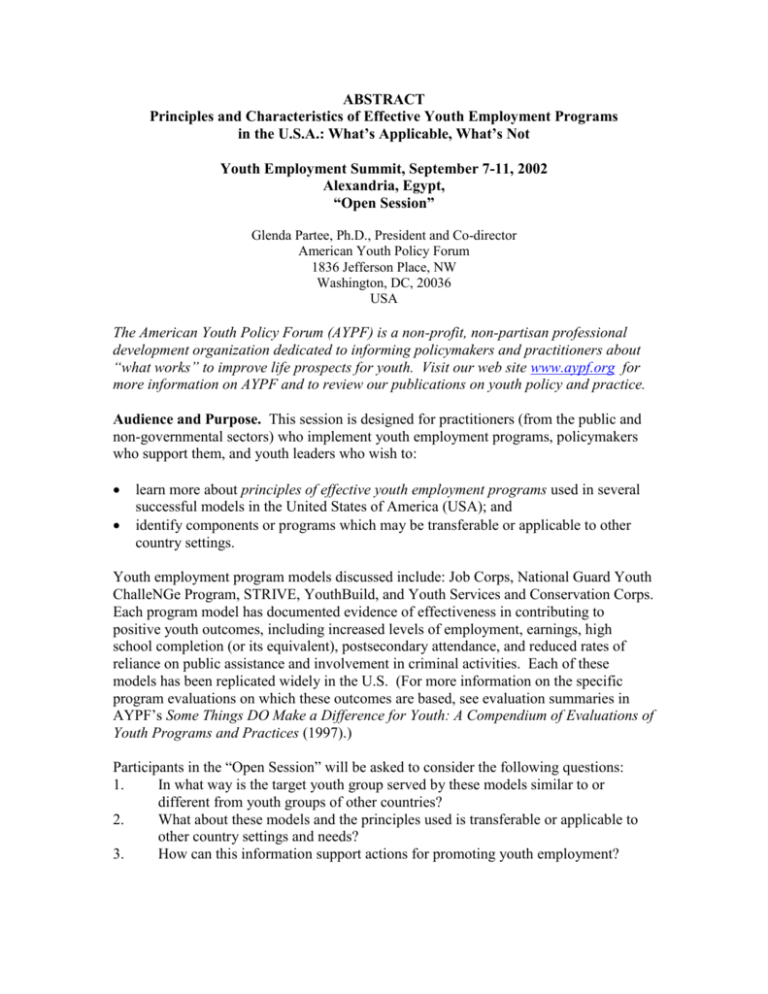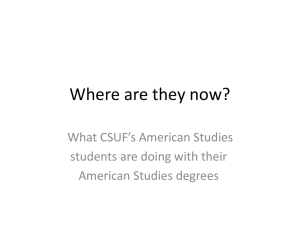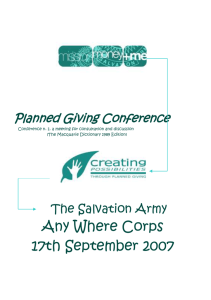Models of Youth Employment Programs in the U
advertisement

ABSTRACT Principles and Characteristics of Effective Youth Employment Programs in the U.S.A.: What’s Applicable, What’s Not Youth Employment Summit, September 7-11, 2002 Alexandria, Egypt, “Open Session” Glenda Partee, Ph.D., President and Co-director American Youth Policy Forum 1836 Jefferson Place, NW Washington, DC, 20036 USA The American Youth Policy Forum (AYPF) is a non-profit, non-partisan professional development organization dedicated to informing policymakers and practitioners about “what works” to improve life prospects for youth. Visit our web site www.aypf.org for more information on AYPF and to review our publications on youth policy and practice. Audience and Purpose. This session is designed for practitioners (from the public and non-governmental sectors) who implement youth employment programs, policymakers who support them, and youth leaders who wish to: learn more about principles of effective youth employment programs used in several successful models in the United States of America (USA); and identify components or programs which may be transferable or applicable to other country settings. Youth employment program models discussed include: Job Corps, National Guard Youth ChalleNGe Program, STRIVE, YouthBuild, and Youth Services and Conservation Corps. Each program model has documented evidence of effectiveness in contributing to positive youth outcomes, including increased levels of employment, earnings, high school completion (or its equivalent), postsecondary attendance, and reduced rates of reliance on public assistance and involvement in criminal activities. Each of these models has been replicated widely in the U.S. (For more information on the specific program evaluations on which these outcomes are based, see evaluation summaries in AYPF’s Some Things DO Make a Difference for Youth: A Compendium of Evaluations of Youth Programs and Practices (1997).) Participants in the “Open Session” will be asked to consider the following questions: 1. In what way is the target youth group served by these models similar to or different from youth groups of other countries? 2. What about these models and the principles used is transferable or applicable to other country settings and needs? 3. How can this information support actions for promoting youth employment? Principles and Characteristics of Effective Youth Employment Programs in the U.S.A.: What’s Applicable, What’s Not In 1997, the American Youth Policy Forum (AYPF) set out to identify practices and programs with documented evidence of effectiveness in youth programming (as determined by independent evaluators). Our efforts were motivated by the desire to help refute the prevailing assumption among many national leaders that— National policy and investment in youth employment training, primarily for economically disadvantaged youth with multiple challenges to successful employment,1 had not been successful.2 There was a pervading sense that “nothing works,” therefore, why bother? Why invest in efforts to improve youth employment?3 We knew that there were a number of programs with documented records of success with young people, particularly low-income youth, and set about collecting evaluations of a range of youth programs (including those focused on employment outcomes).4 Principles of effective youth employment programs. From approximately 100 programs included in our compendia, we noted a number of common principles: Implementation quality—factors contributing to successful implementation include ample start-up time; clear communication of goals; sufficient, timely and sustained resources; strong leadership from the federal, state or local levels; staff development; and use of data to improve performance. Caring, knowledgeable adults—can be teachers, counselors, mentors, case workers, community members, program directors or other trained individuals who understand and deeply care about youth, provide young people with significant time and attention, and demonstrate that they are “in for the long haul.” Also, they must be knowledgeable and, therefore, should receive extensive training in working effectively and compassionately with young people and in providing age-appropriate activities that follow sound youth development principles. High standards and expectations—successful programs do not water down their standards, but maintain high standards of performance for young people and offer supports so that they can meet these standards. Importance of community—effective programs find ways to integrate and use community members (parents/guardians/employers) as resources (e.g., to support planning, extend curricula, provide additional cadres of caring adults and as a natural base of advocacy). A holistic approach—including a broad set of strategies and services to address varying needs of young people (e.g., extended hours, individualized attention, handson instruction, enrichment activities, culturally-sensitive activities, child care and transportation, life skills and assertiveness training, recognition/rewards, a focus on peer support). Youth as resources/community service and service-learning—opportunities for young people to contribute to their communities in positive ways, while also using 1 community work as context for helping youth develop and apply critical skills important in the workplace and in life. Work-based learning—adding “authencity” to the learning experience and ensuring that skills learned are likely to lead to employment. Long-term services/support and follow-up—of six-months to several years, providing opportunities for young people to continue relationships with caring, knowledgeable adults and bridge the critical early months of employment or other endeavors. Although every program did not reflect all of the above principles, invariably the best programs were those that incorporated all or most of these principles, not just a few. Following is a brief overview of four youth employment models, describing the youth population served, basic components, outcomes, and funding sources. Before reviewing these models, a few caveats about youth employment programs in the U.S.A. are in order: 1. 2. 3. Federal government support for youth employment efforts has primarily been targeted to economically disadvantaged youth and those with significant challenges to successful employment (e.g., school dropouts with low-basic skills, disabled youth, young parents). Other avenues to employment for young people exist through formal secondary and postsecondary education and business-supported on-the-job training, but they are not discussed in this paper. Many youth employment programs that have been replicated and supported by the U.S. government originally developed from privately supported or local, community efforts. Discussion There is great commonality across the model youth employment programs reviewed. Each provides a broad set of strategies and services to address the needs of the target youth population, though each takes a slightly different approach in the strategies used. All offer some form of on-site social services programs (case management, counseling, crisis intervention, information and referrals), and in some cases, gender specific individual and group activities. Each tries to inculcate work appreciation values and incorporates work readiness skills and authentic work-based experiences. Though they sprout from different sources (e.g., through federal legislation or as community-based initiatives), have very different histories, operate at different funding levels, and have different philosophies, each creates a particular structure and environment to build participant confidence, skills and value as a productive individual and community citizen. Today’s 108 service and conservation corps trace their roots back to the Civilian Conservation Corps (CCC) of the 1930s. The CCC was one of the most successful public work efforts in U.S. history and provided alternative employment for 500,000 unemployed youth derailed by the U.S. economic depression. They were put to work in forests, parks and rangelands.5 In contrast, YouthBuild had its origins in 1978, when a 2 group of New York City teenagers expressed their desire to renovate abandoned buildings and revitalize their community. Whereas both YouthBuild and STRIVE have community-based origins and seek to prepare young people for entry-level employment in urban areas, the Job Corps and the National Guard ChalleNGe Program seek to take youth out of their communities to residential settings. The programs also differ in program length and intensity. STRIVE offers a short threeweek training program focused on developing the “soft skills” (work ethic, verbal and non-verbal communication) necessary to access and succeed in entry-level jobs. The assumption is that once the young person experiences initial success on the job, they can be mentored and motivated to take the next steps to prepare for a more ambitious career through further education and training. The three-week training program is coupled with longer-term follow-up support through the ensuing two years of the participant’s experience in the world of employment (and a life-long safety net should longer assistance be required). STRIVE was a forerunner in promoting the importance of a follow-up system to track and support participants long after they are hired.6 The principle of extended follow-up is now widely promoted in youth programs supported through federal workforce legislation. In contrast, Job Corps’ program is open-entry, open-exit, and self-paced designed to help young people develop academic and occupational skills before placement in jobs. YouthBuild, on the other hand, expects young people to enter as a cohort and runs programs on an average 12-month cycle. The National Guard ChalleNGe Program, has a two-phase process—a five-month residential phase, followed by a community-based mentoring phase extending one year. Among the special characteristics of these models is STRIVE’s attitudinal training, which has been widely recognized as a unique brand of employment preparation geared toward empowering disadvantaged individuals. The unique characteristic of National Guard ChalleNGe Program is its paramilitary structure designed to provide structure and discipline in the lives of young people who have not experienced success in regular school settings. Among YouthBuild’s special features is providing youth an immediate visible role in rebuilding their communities and helping to develop a value system strong enough to compete with “the culture of the streets.” Leadership development is woven into every aspect of YouthBuild. Through workshops and weekend retreats, trainees learn decisionmaking, group facilitation, public speaking, and negotiating skills and are given opportunities to use and fine-tune these skills as they design and participate in community improvement projects. Participants also learn to advocate for issues that concern them and their communities. YouthBuild trainees testify before Congress and in their state houses. They take an active role speaking out in their communities on a wide range of issues. Young people also share in the governance of their own program and participate actively in community affairs, learning the values and the life-long commitment needed by effective and ethical community leaders.7 3 Program Summaries Job Corps. Job Corps is the largest and most comprehensive residential, education and job training program for at-risk youth, ages 16 through 24 in the U.S. Since its inauguration in 1964, Job Corps has provided more than 2 million disadvantaged young people with the integrated academic, vocational, and social skills training needed to gain independence and get quality, long-term jobs or further their education. Enrollment in Job Corps is voluntary and programs are open-entry, open-exit and self-paced. The average length of stay in is 6 to 8 months. Today, Job Corps serves nearly 70,000 students a year at 119 Job Corps centers throughout the country.8 Job Corps is funded through the Workforce Investment Act and is a public-private partnership, administered by the U. S. Department of Labor (DOL). The majority of Job Corps centers are managed by major corporations and non-profit organizations under contract to DOL. The remainder are operated by the U.S. Departments of Agriculture and Interior under interagency agreements with DOL. Due to its residential nature and extensive interventions for those youth judged in the greatest need, Job Corps has always been the most expensive federally supported job training program. Benefit-cost analyses have shown that, despite the high cost, the values of these benefits outweigh the costs.9 Researchers document returns of about $2 to society for every dollar spent.10 Among the documented gains for disadvantaged youth are: earnings gains, educational progress, and other positive changes across most groups of participants. Key components include: Entry diagnostic testing of reading and math levels Occupational exploration programs and world of work training A comprehensive basic education program, including reading, math GED, health education, parenting, introduction to computers and driver education Competency-based vocational education Zero tolerance for violence and drugs Inter-group relations/cultural awareness programs Social skills training Counseling and related support services Regular student progress reviews Student government and leadership programs Community service through volunteer and vocational skills training programs Work experience programs Health care Recreation programs and avocational activities Meals, lodging and clothing Incentive-based allowances Child care support Post-program placement and support11 4 National Guard Youth ChalleNGe Program. The National Guard Youth ChalleNGe Program (ChalleNGe) program was authorized through the National Defense Authorization Act (1993) and is sponsored and managed by the National Guard Bureau through agreements with State Governors and Adjutants General (the local senior member of the National Guard) of the requesting states. ChalleNGe uses governmentowned facilities and equipment, which keeps the program costs down. ChalleNGe aims to provide dropout youth (ages 16-18) with values, life skills, education and self-discipline. Eligible candidates must be unemployed at the time of application, not currently involved with the criminal justice system, and drug free. ChalleNGe is composed of a five-month quasi-military residential phase, followed by a community-based mentoring phase extending for one year. The residential phase includes academic and vocational education, leadership development, training in the core components areas focused on the growth of participant youth as individuals and citizens, and development of a life plan. Following graduation from the residential phase, participants (called cadets) enter a 12-month community-based phase in which they are assisted by a mentor as they enter the workforce or continue their schooling. A program coordinator maintains regular contact with the cadet and the mentor throughout this stage. The ultimate goal of ChalleNGe is to place all participants who graduate from the first phase of ChalleNGe into jobs, military service and/or postsecondary education programs. At the end of their five-month residential phase, participants report high levels of community service, an average grade-level increase of over one year in reading and math, 72 percent of graduates had received their GED, and high completion rates from the program. Upon completion of the residential phase, less than 1 percent had gotten into trouble with the justice system and were incarcerated. Whereas one quarter were employed and about the same percent were in postsecondary education, 10 percent had enlisted in the military; and the remainder were either awaiting notification of acceptance from colleges, employers or the military or returning to high school.12 STRIVE (Support Training Results in Valuable Employment). STRIVE is a privatelyfunded organization. It was established in 1984 by a corporate businessman and principals from a non-profit community agency in New York City’s East Harlem. Its goal is to provide inner-city young adults (18 to 30) who have experienced difficulty in securing and maintaining employment with the tools for successfully entering the job market. STRIVE's clientele includes former substance abusers, high school dropouts, youngsters phasing out of the foster care system, ex-offenders, single parents receiving public assistance, working poor and individuals who have become disengaged from employment. Historically, enrollment has reflected a 2 to 1 ratio of women to men, and 96 percent of the participants have been people of color (i.e. African American, Latino). Close to 50 percent of the current staff were at one time STRIVE participants themselves. In addition to four core sites in New York City, a number of affiliated sites within other community based organizations offer the full complement of STRIVE services to their respective participants, and are administered by certified STRIVE staff. Additionally, there are a number of sites located within the United States and internationally that have 5 replicated the entire STRIVE System, either as a stand-alone program, a part of a collaborative of agencies, or as a separate component within an existing organization. Program components include: (1) an intensive intake, assessment and orientation process designed to determine participants’ readiness for training; (2) a three-week workshop providing training to promote attitudinal change and skills necessary for job success, including communication skills, testing in reading and mathematics and referrals, where necessary, to education services, and moderate computer training; (3) job development; (4) on-site social services and referrals; and (4) follow-up services post job placement for up to two years. Independent evaluators document sustained levels of employment (of at least two years) for approximately 80 percent of participants. Employers reported high levels of motivation among participants and 63 percent of employers maintained a relationship with STRIVE for an average of one to two years.13 Youth Services and Conservation Corps. Over 100 corps organize out-of-school youth, 18-25 years old, into crews under the direction of adult staff to carry out community service projects, usually in the environment and human services. Youth Corps enroll over 22,000 young people in summer and year-round programs in 32 states. Annually, these young people provide over 14 million hours of service to their communities. Corps are intended to provide long-term benefits to the public, instill a work ethic and a sense of public service in participants, and be of substantial social benefit in meeting unmet human, educational or environmental needs in the community where volunteer service is performed. Corps operate with funds from federal, state, local and contractual sources.14 Service corps vary, but generally provide temporary paid employment in service activities (about 32 hours/week), and a mix of services (about 8 hours/week). Typical program components include: Introduction to the world of work Job training Job search Basic and remedial education, including GED preparation and a combination of both contextual, “hands-on” learning and traditional classroom education Life skills training Paid work above the minimum wage Evaluation studies show that 15 months after entry into the youth corps, participants exhibit gains over control groups in employment rates and hours worked, and fewer arrests. Significant impacts were found by gender and race/ethnicity specifically for youth of color (e.g., African American males showed higher earnings, higher employment levels, were more likely to earn a two-year postsecondary degree and to raise their educational aspirations).15 6 YouthBuild (YB) YouthBuild USA is a comprehensive youth and community development program as well as an alternative school. YouthBuild, designed to run on a 12-month cycle, offers job training, education, counseling, and leadership development opportunities to unemployed and out-of-school young adults, ages 16-24, through the construction and rehabilitation of affordable housing in their own communities. Many graduates go on to construction-related jobs or college. Alumni receive post-program counseling. The buildings that are rehabilitated or constructed during the program are usually owned and managed by community-based organizations as permanent low-income housing. Community-based, independent organizations operate local YouthBuild programs, which are kept small to create supportive mini-communities for the students. Each YouthBuild program is responsible for its own funding, with a mix of government funding—federal (through the U.S. Department of Housing and Urban Development), state and local—and private support from foundations and corporations in their geographic area. There are over 160 programs engaging 6,000 young people, ages 16 to 24, in 43 states. Approximately 70 percent are male and 30 percent are female. They are racially diverse-55 percent African American, 20 percent Caucasian, 22 percent Latino, 1.5 percent Asian American, and 1 percent Native American. Ninety percent are from very low-income families. An average of 30 percent are adjudicated youth who have been referred to the program by the court system, but some programs are designed to accept 60 to 100 percent of participants through court-related referrals. Evaluations show favorable outcomes related to GED attainment, positive behaviors related to time management, leadership proclivity, caring for children, and ethics, drugs and crime. Since 1993, YouthBuild students have built more than 7,000 low-income housing units. On average, 60 percent of YouthBuild students remain until they complete the program. Of those, 85 percent go on to college or construction-related jobs. Alumni receive post-program counseling and have continued opportunities to play leadership roles in the local YouthBuild chapter and in the community.16 1 Typically, these are young people who are largely undereducated and unskilled, who are not currently in school or in jobs and are seeking opportunities to further their education and prepare for the workforce. They are the “The Forgotten Half,” those approximately ten million 18 - 24 year-olds who neither complete high school nor continue their formal education beyond high school graduation (Halperin, The Forgotten Half Revisited, 1998). 2 The major employment training legislation at the time was the Job Training Partnership Act (JTPA) of 1983 which provided job-training services for economically disadvantaged adults and youth. Two titles of this legislation focused on youth: (a) summer jobs and training, which included a range of activities that are available during the summer vacation months that enhance basic skills, encourage school completion, provide exposure to the world of work and enhance citizenship skills; and (b) year-round 7 training and employment programs for both in- and out-of-school youth, which offered limited internships in the private sector, school to work transition services and alternative high school services. 3 Evaluations indicated the effects of JTPA programs on youth were zero or negative when judged by performance outcomes of improved employment and wages. See Grubb, W.N. (1995) Evaluating Job Training Programs in the United States: Evidence and Explanations. National Center for Research on Vocational Education Technical Assistance Report, MDS-1047. University of California at Berkeley. 4 See American Youth Policy Forum. Some Things DO Make A Difference for Youth: A Compendium of Evaluations of Youth Programs and Practices (1997) and MORE Things That DO Make A Difference for Youth (1999) at http://www.aypf.org. Each of the Compendia contains nearly 50 summaries of evaluations of youth interventions that are shown to improve the lives of young people. In an easy-toread format, these summaries highlight research findings, describe the key components, and share what is known about the ingredients of success underlying each program. 5 History of the Youth Corps Movement. http://nascc.org/history2.shtml. 6 See STRIVE Central website: http://www.strivecentral.com. 7 See YouthBuild USA website: http://www.youthbuild.org. 8 About Job Corps. http://jobcorps.doleta.gov/about.asp. 9 Grubb, W. N. (1995). Evaluating Job Training Programs in the United States: Evidence and Explanations. National Center for Research on Vocational Education Technical Assistance Report, MDS-1047. University of California at Berkeley, National Center for Research in Vocational Education, Graduate School of Education. 10 Burghardt, J. et al. (2001) Does Job Corps Work? Summary of the National Job Corps Study. Princeton, NJ: Mathematica Policy Research, Inc. 11 American Youth Policy Forum. (1997). Some Things DO Make a Difference for Youth: A Compendium of Evaluations of Youth Programs and Practices. Washington, DC. 12 Ibid. 13 About STRIVE Central. http://www.strivecentral.com/sites/coresites/strivecenral.htm. 14 Corps History. http://www.nascc.org/history2.shtml. 15 American Youth Policy Forum. (1997). Some Things DO Make a Difference for Youth: A Compendium of Evaluations of Youth Programs and Practices. Washington, DC. 16 Hernandez, R. (2001). YouthBuild, U.S.A. YIA Fact Sheet. http://www.ncjrs.org/txtfiles1/ojjdp/yfs00106.txt. 8





